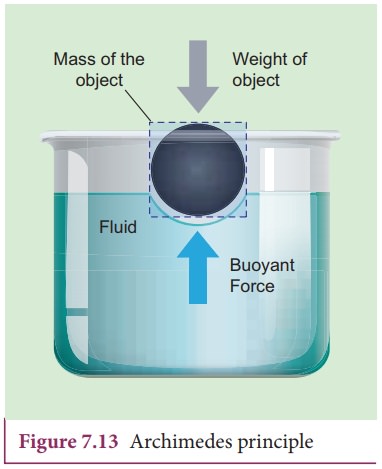Properties of Matter - Buoyancy | 11th Physics : UNIT 7 : Properties of Matter
Chapter: 11th Physics : UNIT 7 : Properties of Matter
Buoyancy
Buoyancy
When a body is partially or fully immersed in a fluid, it displaces a certain amount of fluid. The displaced fluid exerts an upward force on the body. The upward force exerted by a fluid that opposes the weight of an immersed object in a fluid is called upthrust or buoyant force and the phenomenon is called buoyancy.
Archimedes principle:

It
states that when a body is partially or wholly immersed in a fl uid, it
experiences an upward thrust equal to the weight of the fluid displaced by it
and its upthrust acts through the centre of gravity of the liquid displaced.
upthrust or buoyant force = weight
of liquid displaced.
Law of floatation
It
is well-known that boats, ships, and some wooden objects move on the upper part
of the water, we say they fl oat. Floatation can be defined as the tendency of
an object to rise up to the upper levels of the fluid or to stay on the surface
of the fluid.
![]()
![]() The law of floatation states that a body will float in a
liquid if the weight of the liquid displaced by the immersed part of the body
equals the weight of the body. For example, a wooden object weighs 300 kg
(about 3000 N) floats in water displaces 300 kg (about 3000 N) of water.
The law of floatation states that a body will float in a
liquid if the weight of the liquid displaced by the immersed part of the body
equals the weight of the body. For example, a wooden object weighs 300 kg
(about 3000 N) floats in water displaces 300 kg (about 3000 N) of water.
EXAMPLE 7.8
A
cube of wood floating in water supports a 300 g mass at the centre of its top
face. When the mass is removed, the cube rises by 3 cm. Determine the volume of
the cube.
Solution
Let
each side of the cube be l. The volume occupied by 3 cm depth of cube,
V=(3cm)
├Ś l2 = 3l2cm
According
to the principle of floatation, we have
VŽüg
= mg ŌćÆ VŽü = m
Žü
is density of water = 1000 kg m-3
(3l2
├Ś 10-2m) ├Ś (1000 kgm-3)=300 ├Ś 10-3ŌĆåkg

l = 10 ├Ś 10-2m = 10 cm
Therefore,
volume of cube V = l3 = 1000 cm3
Examples of floating bodies:
i)
A person can swim in sea water more easily than in river water.
ii)
Ice floats on water.
iii)
The ship is made of steel but its interior is made hollow by giving it a
concave shape.
Related Topics